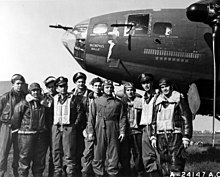George Petty

George Brown Petty IV (April 27, 1894 – July 21, 1975) was an American
Birth and early career
George Petty was born in
Petty was not a particularly good student in high school, spending a great deal of time on extracurricular activities instead of schoolwork. His artistic bent first became obvious in high school, where he was the staff artist for the school newspaper.
During his high school years, he enrolled in evening classes at
Petty returned to Chicago, and worked as an airbrush retoucher for a local printing company. He was able to establish himself as a freelance artist, painting
Artistic influences
George Petty never discussed in detail those artists who influenced him, other than
"The Petty Girl"
Petty is especially known for "the Petty Girl", a series of pin-up paintings of women done for Esquire from its first issue in 1933[1] until 1956.[2] Petty frequently depicted these women with the relative lengths of their legs being longer—and the relative sizes of their heads being smaller—than those of his actual models.
George Petty used his daughter as the model for an optional hood ornament, "Flying Lady" available on the Nash automobiles in the early 1950s.[3]
Petty appeared as a guest on the popular TV program What's My Line? on November 20, 1955.
Petty died in
In popular culture

- An image of a Petty Girl talking on a phone was used as the "nose art" on the famous World War II B-17 Flying Fortress, Memphis Belle.
- In 1959 a vector rendition of a Petty Girl derived from a 1956 Esquire calendar was displayed as part of the diagnostics for a SAGE air defense computer. This is claimed to be "earliest known figurative computer art".[4]
- Two images of Petty Girls were used in the crowd on The Beatles' Sgt. Pepper's Lonely Hearts Club Band album cover.
- Henry Levin and featuring the film debut of Tippi Hedren as one of the Petty Girls. Nat Perrin's screenplay was based on a story by Mary McCarthy. The film is also notable for several lilting, lighthearted songs composed by Harold Arlen (music) and Johnny Mercer (lyrics), including "Fancy Free" and "I Loves Ya". The large production number at the finale is "The Petty Girl" by Arlen and Mercer, performed by Joan Caulfield(dubbed by Carole Richards), the Petty Girls and a male quartet.
Sources
Reid Stewart Austin (The Best of Gil Elvgren) examined the life and art of George Petty in the 192-page Petty: The Classic Pin-Up Art of George Petty. Published by Gramercy in 1997, the lavish volume features a foreword by Hugh Hefner and an introductory essay by Petty's daughter, Marjorie Petty, who was his main model. In The New York Times Book Review, famed designer George Lois praised this collection of Petty's creations, commenting:
Just as the cool, unapproachable Gibson Girl was the feminine ideal of young men at the turn of the century, the voluptuous Petty Girl became the ideal of their wide-eyed sons. I'm going on the record to swear that George Brown Petty IV consistently created better-designed women than God, and now I've got a big beautiful book to prove it.
References
- ^ Petty, George (September 1, 1933). "Pardon Me, Miss, I Didn't See the Tennis Racket — I Thought You Had Forgotten Something". Esquire (1): 66. Retrieved January 19, 2023.
- ^ "George Petty". The Pin-up Files. Archived from the original on August 29, 2004. Retrieved December 16, 2021.
- ^ "Hood Ornaments for Nash and Related Cars".
- ^ Edwards, Benj (January 24, 2013). "The Never-Before-Told Story of the World's First Computer Art (It's a Sexy Dame)". The Atlantic. Archived from the original on February 17, 2013. Retrieved February 16, 2013.
